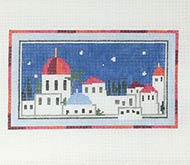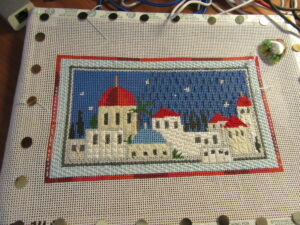
This lovely Pippin Studio canvas is called Jerusalem. I love it and am stitching it currently (the stitch guide will be available in early 2024 in my Etsy shop).
But all those white buildings pose a challenge for the stitcher: How do you make them distinct? There are several approaches you could take. In this article, I’ll look at each one, analyze the defects, and show you my solution and why it works.
All one thread and stitch: Needlepoint when stitched tends to flatten the planes present in the design. Although in the pictureof the canvas, you can see how some buildings are in front of others. Stitching the buildings in a single thread and stitch will make it look more as if it was one large building with the grey lines as interruptions.
Different stitches, same thread: If you pick different stitches, you can get a sense of depth. This is particulary true if you follow the rules of perspective by choosing smaller, more open stitches for items that are further back in the visual planes of the picture. This would solve the flatness problem, but it would still look like a single visual entity.
It’s better, but not great.
Different threads, same stitch: By choosing a. variety of white threads, you can also get a feeling of perspective. The diiferent textures of the threads makes each building different from its neighbors. This is a goodsolution because it fixes the problems of flatness and allows the design to look like buildings, not one building.
Can we push it further?

Different threads & stitches If, instead of using one stitch for the buildings, we use a variety of titches, each building gets a clear individual identity. They are still united by the white color of the threads, but the city now looks like a city, with different buildings built at different times and in different ways.
In other words, it look alive.
Take-aways
When you hava a design with sevewral objects the same color as your focal point, stive to make each object slightly different. Do this by picking threads in different textures and slightly different texures. Vay your stitches, even if they are only slight variations of the same sttitch. Keep stitches and threads that are similar away from each other. Doing this will create a design that looks more realistic.
About Janet M Perry
Janet Perry is the Internet's leading authority on needlepoint. She designs, teaches and writes, getting raves from her fans for her innovative techniques, extensive knowledge and generous teaching style. A leading writer of stitch guides, she blogs here and lives on an island in the northeast corner of the SF Bay with her family
Leave a Reply